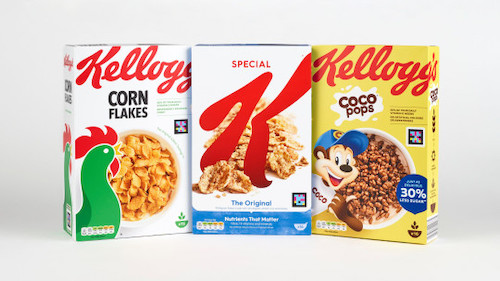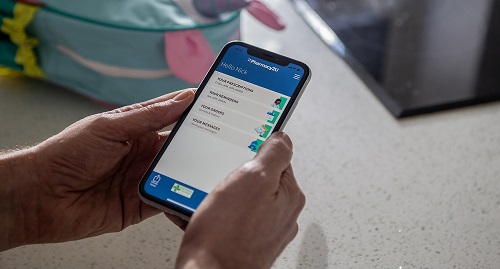
Kellogg’s to roll out cereal boxes with world-first technology for blind and visually impaired people
This is an updated post from our archives. Kellogg’s has introduced NaviLens technology on its cereal boxes, enabling blind and visually impaired individuals to access product information via smartphones, enhancing accessibility and independence.
Other Brands Enhancing Packaging Accessibility
Following Kellogg’s initiative, several other brands have adopted accessible packaging to support blind and visually impaired consumers:
- Procter & Gamble’s Herbal Essences: Introduced tactile notches on shampoo and conditioner bottles to help differentiate between products by touch.
- Unilever’s Degree Inclusive: Developed a deodorant designed for people with visual impairments and upper-limb disabilities, featuring braille labels and an easy-to-open magnetic closure.
- Coca-Cola: Implemented NaviLens technology on beverage packaging in the UK, allowing visually impaired consumers to access product information via smartphone.
These advancements demonstrate a growing commitment to inclusive design, enabling disabled people to shop more independently and make informed choices. For more information on accessible packaging, visit the Royal National Institute of Blind People (RNIB).
original post follows:
Kellogg’s cereal brand shared some exciting news: after a successful test, they’ve decided to add a brand-new, world-first technology to all their cereal boxes. This cool tech will help blind and visually impaired people access information about their cereal.
Important information on food packaging, such as allergen details, can often be in print that’s difficult for blind or partially sighted people to read.
Using NaviLens technology, the new boxes will allow a smartphone to easily detect a unique on-pack code and playback labelling information to the shopper with sight loss.
The company will change all its cereal packaging, beginning in 2022, with the first accessible boxes of Special K appearing on shelves in January.
Kellogg’s idea of smart read technology
The idea came to life when Kellogg’s met with children from St Vincent’s in 2019, a specialist school in Liverpool for children with sensory impairments. It was the pupil’s insight that inspired the business to look for solutions.
Kellogg’s also hopes that by sharing its experience with other brands there is an opportunity to make the supermarket shelves more accessible for people with sight loss so they can shop more independently and access information from a range of packaging.
Kellogg’s successful UK trial

This announcement comes after a successful UK trial last year in partnership with Co-op, on Kellogg’s Coco Pops boxes.
Evaluation of the pilot by charity Royal National Institute of Blind People (RNIB) showed that 97% of the participants agreed that they would like to see more of these accessibility features available on grocery packaging in the future.
How the NaviLens technology works

Unlike other types of printed codes, the new NaviLens technology includes high contrasting-colored squares on a black background. Users do not need to know exactly where the code is located to scan it.
It allows smartphones to pick up the on-pack code from up to three metres distance when a blind or visually impaired shopper points their device in the direction of the cereal box.
This then alerts the phone, and the shopper can choose to have the ingredients, allergen and recycling information read aloud to them – as well as reading it on their device using accessibility tools.
The technology is currently used across Barcelona, Madrid and Murcia city’s transport systems, making the cities easier to navigate for thousands of visually impaired citizens.
What is the NaviLens App?
The NaviLens app is a revolutionary tool designed to enhance independence for blind and visually impaired people. By simply scanning a specially designed NaviLens code using a smartphone camera, users can access detailed product information, including ingredients, allergens, and preparation instructions, via audio or text.
The app is available for free on both iOS and Android devices. It is easy to use and requires no focus alignment, making it perfect for quickly locating and identifying products in stores or at home.
This innovation empowers users to shop more independently, ensuring they have access to the same product information as sighted consumers.
Reactions by Kellogg’s and its partners
Chris Silcock, head of Kellogg’s UK, said: “Over two million people in the UK live with sight loss and are unable to simply read the information on our cereal boxes.
As a company focused on equity, diversity and inclusion we believe that everyone should be able to access important and useful information about the food that we sell.
That’s why, starting next year, we are adding new technology to all of our cereal boxes.
I am proud that Kellogg’s will be the first company in the world to use NaviLens on packaging. We know it’s important that all packaging is accessible for the blind community to enable them to make shopping easier, so we will share our experience with other brands who want to learn more.”
Javier Pita, CEO of NaviLens, the start-up company that created the technology commented: “The incorporation of the NaviLens codes onto food packaging is a positive step towards a more inclusive and accessible shopping experience for the visually impaired. This allows people with sight loss to shop more independently and make their own food choices.”
Marc Powell, strategic accessibility lead at RNIB, said: “This announcement from Kellogg’s is a real game changer within the packaging world. It marks a significant step-change in how big brands can put accessibility at the forefront of design and packaging decisions and be a catalyst for change.
Important information on packaging can often be in very small print, making it difficult or impossible for people with sight loss to read.
Changes like this can provide blind and partially sighted people with vital information for the very first time, giving us the same freedom, independence and choice as sighted customers.
“Designing packaging so that it works for everyone makes complete sense and we hope that other brands will follow Kellogg’s lead in making packaging information more accessible.”
The first Kellogg’s cereal boxes with the assistive technology hit supermarket shelves in January 2022.
By Emma Purcell
Originally posted on 07/07/2021 @ 11:00 am